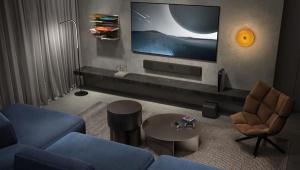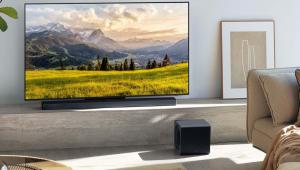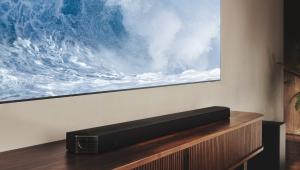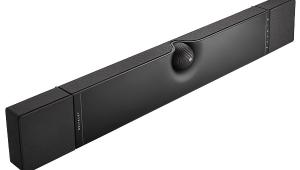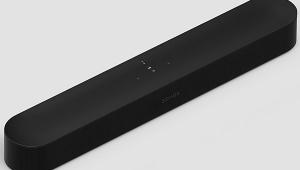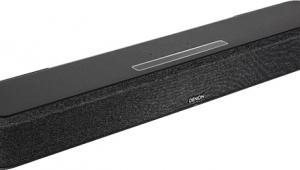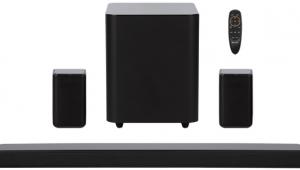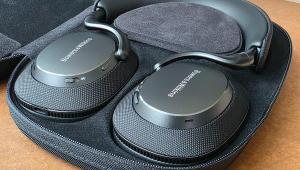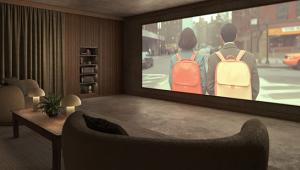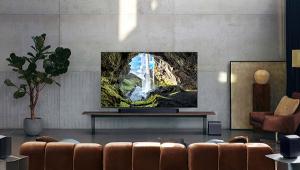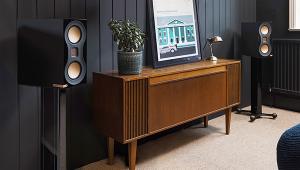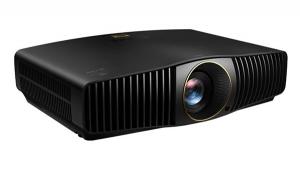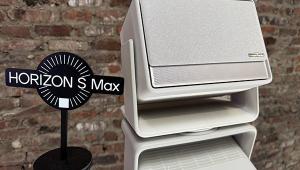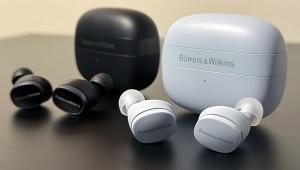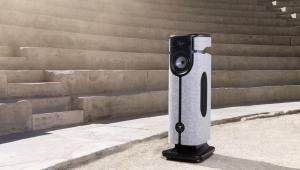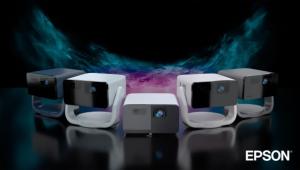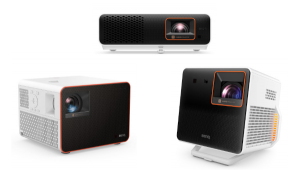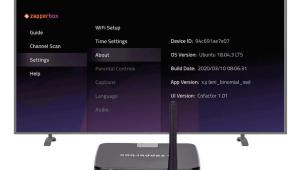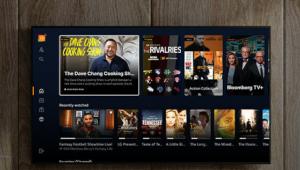Samsung's "Dolby Atmos 11.4.1 in a Box" HW-Q990F Soundbar is Wireless and Immersive

AT A GLANCE
Plus
Superb vocal clarity
Excellent object placement in surround sound
Music is supported in surround sound as instruments play around the room
Direct wireless connectivity
Minus
No on-screen settings or home screen
Difficult to change settings on the scrolling front LED—must use phone app.
Music is acceptable, but highs are occasionally shrill.
THE VERDICT
The home theater experience created by the Samsung HW-Q990F soundbar system is surprising—a true alternative to an AV receiver and individual speakers. The AI controls create a clear, immersive experience with excellent dialog for movies and clear vocals for music that automatically calibrates to your room. It's an excellent home theater sound choice.
The HW-Q990F is the next-generation Samsung flagship soundbar following the HW-Q990D. Like its predecessor, it comes with a front soundbar, two rear speakers, and a subwoofer. This year's model is smaller than the Q990D, yet it's designed to increase power and efficiency with dual opposing eight-inch woofers that use AI Dynamic Bass Control to optimize the lower frequencies.
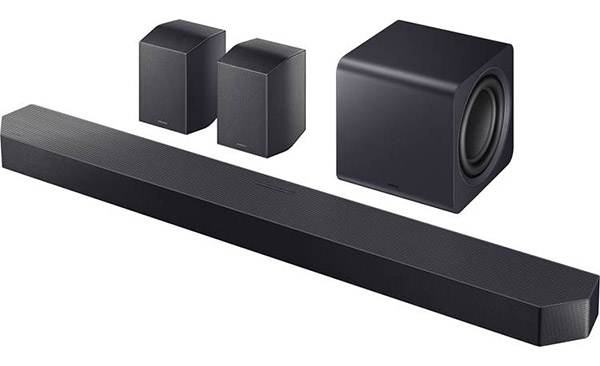
The Q-990F includes a total of 23 individual speakers with 15 speakers in the soundbar alone, two in the subwoofer, and three in the rear speakers—a front-facing, side-facing, and up-firing driver. AI uses information about the room's reverberation to expand the soundstage and create the object-based sound of Dolby Atmos. The result is an immersive full-room experience with sound effects flying overhead and music surrounding you.
While it's not the only Dolby Atmos Soundbar on the market, it does shine compared to its competitors. The Nakamichi DRAGON requires manual setup to calibrate the speakers to your room, and the JBL Bar 1300X has small detachable speakers that are used as the rear surround speakers.
The HW-Q990F soundbar, rear speakers, and bass speaker use a direct wireless connection so there are no wires to run up the wall to the TV, or across the room to the rear speakers.
Samsung has included a remote with the system, but it's much easier to control and adjust the soundbar and speakers using the SmartThings app for mobile, which is also used to set up the soundbar. The universal remote on compatible Samsung TVs will instantly control the soundbar's volume and other basic functions.
Users can connect any TV brand to the HW-Q990F to receive great surround sound, but many Samsung TVs offer the added benefit of Q-Symphony. Q-Symphony utilizes the TV's internal speakers, adding to those of the soundbar for an even fuller sound.
Features
Users can toggle on several sound adjustments that use artificial intelligence (AI) to automatically change to optimize the audio. The surround system is automatically calibrated using Samsung's SpaceFit Sound Pro. Other AI adjustments can be turned on to personalize the audio or to quickly make changes for individual shows.
SpaceFit Sound Pro - When this is turned on, sound is optimized for the room by using sensors embedded in the soundbar and the speakers to measure the reverberation and adjust the audio.
Active Voice Amplifier Pro (AVA) - This is more than voice enhancement. It adjusts the dialog based on the background noise in your room, less when it's quiet, and more if a vacuum or fan is running.
Adaptive Sound+ - analyzes the video content and makes adjustments to sound levels based on what's on-screen—whether it's whispering dialogue or a car chase scene.
Dynamic Bass Control AI - uses AI to adjust the dynamic phase control, lower volume, or boost bass to offset human sensitivity, uses non-linear bass management, and prioritizes equalization.
Works with voice assistants to control soundbars and other compatible smart devices using the soundbar as a hub. Works with Bixby, Alexa, and Google Assistant.
Eclipsa Audio compatible—Developed by Samsung and Google, this object-based format "places" sound in precise spots around the room using 28 individual audio channels.
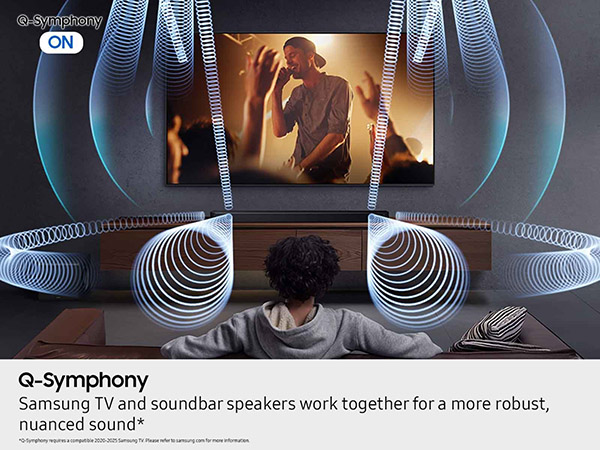
Because the rear speakers are not wired to the soundbar, Samsung offers a couple of options for when you are not using them as part of the surround system.
You can turn on Private Rear Sound with the toggle switch in the SmartThings app. This shifts all of the sound to the rear speakers and turns off the sound bar, reducing the reverberated surround sound in the room for times like late at night when you don't want to disturb others.
When you want to extend music to a nearby room, plug the rear speakers into a wall socket and turn on Sound Grouping. Sound will play on both the soundbar and the rear speakers. Because the speakers use a direct wireless connection and not WiFi, there are distance limitations to where you can put them and still receive a signal.
The rear speakers each have three individual speakers for immersive sound, but if you want more, the HW-Q990F supports adding up to three additional speakers.
Setup
The setup was ridiculously simple once I downloaded and logged into the SmartThings app on my iPhone. I placed and plugged in the subwoofer, the soundbar, and the rear speakers, being sure that the rear speakers were positioned so their top-firing speaker was aimed at the ceiling and not a skylight, their side speaker could bounce off a wall, and the other side speaker was facing where I sit. Immediately, each speaker connected to the soundbar.
Then I used my phone's camera to scan the QR code on the top of the speaker. The phone launched the SmartThings app and immediately added the HW-Q990F.
The remote in the app could now control the soundbar and I could finish setting it up the way I wanted by adjusting the equalizer, volume of each channel, and toggle the AI and other settings
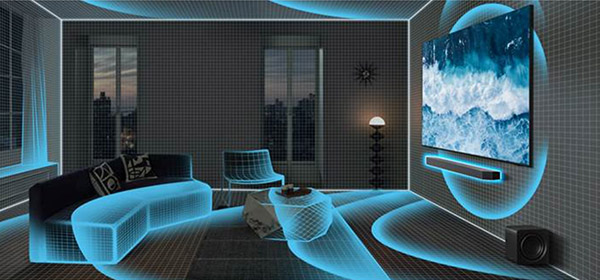
Performance
With 15 speakers in the soundbar, combined with those in the Samsung QN-900F 8K TV using the Q-Symphony feature, it acts as a full surround sound system. The clarity of the dialog is extraordinary in the HW-Q990F soundbar.
Voices are clearer than any sound system, receiver, or speakers I've used. It beats out any device or TV's voice enhancement. I could finally turn off closed captioning and not miss details.
In the past, it's been a challenge to listen to The Voice on my Definitive Technology full floorstanding speaker and AV receiver home theater system. The source sound mix has the voices so quiet that I've had to turn up the volume to 75%. Even with the volume set to 10% on the HW-Q990F, the singer's voices came forward. Dialog was crystal clear.
Sound quality was consistent across all video genres when Adaptive Sound+ was enabled. Whether I was watching quiet dialog in Grey's Anatomy or chaotic activity in Max's new hospital drama The Pitt, it handled both in a way that kept the mood of the scene. Changing to the Virtual Sound setting enhanced the grittiness of The Pitt's ER further. It felt like I was standing next to the doctors. Background conversations came from right and left rears, metal instruments clinking, doors opening, footsteps surrounding me.
Black Panther movie audio was equally impressive. Voices echoed down from high cliffs. Water splashed toward me. Spears whisked past me overhead. It was remarkable that I could pinpoint the exact location of objects from a soundbar and rear speakers.
Likewise, when viewing an underwater YouTube video demo of Dolby Atmos, I could close my eyes and hear the fish swimming through the water—the sound I remember from when I've been snorkeling.
So far, only a few YouTube videos include Eclipsa Audio. I could point to the precise spot in the room where the sound "came from." It will be exciting to see the uses of Eclipsa Audio in future movies and videos. So far it sounds promising.
The HW-Q990F is compatible with most music streaming services, including Chromecast, Apple AirPlay, and Spotify Connect. During testing, I used AirPlay and Chromecast from my iPhone 16. The soundbar was displayed in the list of AirPlay and Chromecast devices. It connected instantly and streamed without issues, even after pausing or taking a phone call.
Streaming the Charlie Brown classic, "Christmas Time Is Here" by Vince Guaraldi in Surround mode was fun as it brought the children's voices from all around the room.
While all songs I played were at least 24-bit/48kHz ALAC lossless, which can be streamed using AirPlay, I would have needed a Roon device or Tidal Connect to stream high-res audio.
There was good vocal and instrumental clarity when streaming the Goo Goo Dolls' "Iris" using AirPlay from Apple Music on my iPhone. Still, the clarity also emphasized that the recording was compressed.
The vocals and mid-range were so clear in other songs like Joni Mitchell's "California" and Neil Young's "Cowgirl in the Sand" that it masked the compression. I could hear the nuanced sound of the microphone picking up Mitchell's emotions. The guitar and piano are likewise full-bodied in Young's classic rock "Cowgirl in the Sand."
Listening to the instrumental As Falls Wichita, So Falls Wichita Falls by Pat Metheny—the complexity of the music was clear and evident, but some high notes became a little shrill at louder volume. Similarly, it felt like I was sitting up front in the audience listening to Appalachian Spring: 1. Very Slowly by Leonard Bernstein and the NY Philharmonic. Yet at times, the treble bordered on shrill, but it appears that the issue was in the source of the streamed music.
The highs were tamed when I listened to Apple Music on Apple TV that was connected to the Samsung TV. Across the board, music was clearer and the highs were beautifully open using the connected device. The best sound came from "Pink Pony Club" in Dolby Atmos. It had a spatial 3D surround sound, and the highs were more subdued (though it also dulled the cymbals), but not shrill. The organ in The Who's remastered spatial audio "Baba O'Riley" danced dizzyingly around the room.
Pandora on the Samsung TV was not high resolution, but some musical details in songs stood out. An echo at the beginning of James Taylor's "Carolina in My Mind" was noticeable when listening but is often missed on other speaker systems.
Conclusion
It's worth choosing the HW-Q990F for the excellent dialog and vocals alone, but it also holds its own as an excellent home theater experience. The 3D object-location-based sound gives the sense of precise effects from 360 degrees, which is usually reserved for surrounding yourself with physical speakers. It'll be even more exact when Eclipsa becomes more available. While listening to music is better on dedicated systems, there are moments that may make you take notice, and it does a great job if you're listening to music in the background.
Specifications
Soundbar dimensions (W×H×D): 48.5"×2.78"×5.4"
Subwoofer (W×H×D): 9.8"×9.9"×9.8"
Rear Speakers (W×H×D): 5.1"×7.9"×5.5"
Number of channels: 11.1.4
Soundbar operating power consumption: 41W
Total number of speakers: 23
Audio Formats: ATMOS Music, ATMOS, Dolby 5.1 Channel, Dolby Digital Plus, Dolby True HD
Surround Sound expansion, Game Pro, Standard, Adaptive Sound, DTS Virtual: X, Voice Enhance Mode, SpaceFit Sound Pro, Active Voice Amplifier Pro,
Night Mode and Moderate Bass
Decoding Formats: MP3, AAC, OGG, FLAC, WAV, ALAC, AIFF
Video: 4K Video Pass 120Hz, HDR10+
Connectivity: 1 HDMI out, 1 HDMI in, eARC, HDMI CEC, Optical In, Bluetooth, Wi-Fi, Bluetooth 5.3.

